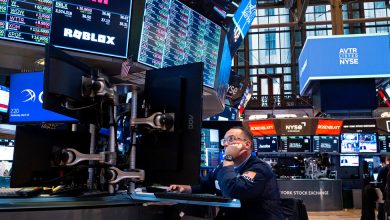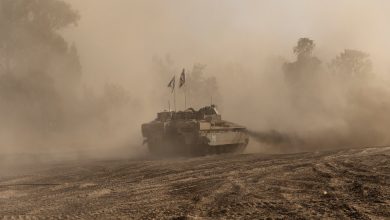A Year Above Ground

BROOKWOOD, Ala. — Braxton Wright is a second-generation coal miner, a die-hard union supporter and, until recently, a staunch Republican. He is named after his uncle, a Korean War veteran, who was fatally crushed between two rail cars while working at the Pullman train factory near Birmingham.
Hard dangerous work is a part of Mr. Wright’s extended family history and that of many people living in this industrial and mining belt of north central Alabama. Next to the coal mine where Mr. Wright works, there is a memorial to the miners who were killed in an underground explosion in September 2001. Every year, on the disaster’s anniversary, a bell tolls once for each of the 13 workers who died.
In agreeing to these dangers, Mr. Wright, 39, says he and his fellow coal miners have come to expect something in return from their employer — respect.
After accepting pay cuts when the coal company emerged from a 2015 bankruptcy, the miners said they expected that their previous wages would be restored to match what other mines paid. The company, Warrior Met Coal, declined to comment for this article. It says on its website that Warrior Met made no such promise and has provided multiple raises in recent years.
On April 1, 2021, Mr. Wright joined about 900 other miners who walked off the job and set up picket lines around the mine’s entrances, demanding that the company raise their wages close to the levels they received before the bankruptcy.

Brian Kelly, the president of Local 2245, protesting unfair labor practices near one of the Warrior Met Coal Mine entrances.Credit…Audra Melton for The New York Times
Less than 30 miles away from where the mine sits is the Amazon warehouse in Bessemer, Ala., a building that encompasses 14 football fields and employs more than 6,000 people. The workers there have recently voted for a second time on whether to form a union.
A previous election last spring ended in a defeat for the union by a wide margin. The most recent results now hinge on a series of disputed ballots that will be reviewed in the coming weeks, but the contest is closer than many anticipated. On Friday, organized labor scored a surprising victory as workers at an Amazon facility on Staten Island voted to unionize.
It is a stark tableau of the American economy: coal miners dug into a contract dispute in a diminished industry and low-wage workers seeking more leverage at a high-tech company whose growth seems limitless.
Forming a union is a significant step, but maintaining a strike for 365 days requires a measure of solidarity that seems difficult to muster in a deeply divided society. The miners are a mix of Trump supporters and Biden voters, Black workers from Birmingham and white workers from rural towns near the mine. They have supported one another with food donations and camaraderie during a year on the picket line.
On most days, instead of getting up to start his shift as an operator in the mine’s control room, Mr. Wright heads to the picket line or to a food pantry and loads his pickup truck with donated groceries to bring to the miners and their families.
“Coal mining is like a brotherhood, like the military,” said Curtis Turner, president of Local 2427 of the United Mine Workers of America, which represents the maintenance workers at the mine. “They would do anything for each other.”
Still, the efficacy of the strike is not clear. Even as the mine operates at a reduced capacity, Warrior Met Coal is generating strong profits and its stock price has soared 125 percent since the strike began.
Even with the union’s support — the miners are paid $800 by the union every two weeks — many have had to get second jobs.
A few have taken jobs at Amazon in Bessemer, including Mr. Wright, who works the overnight shift, sorting items to be shipped around the South.
He knows that coal mining will always pay more because of the danger of the work. But when he encourages his new warehouse colleagues to vote for a union, he makes the case that a union could help new industries like e-commerce start to catch up.
At the mine, Mr. Wright is paid $84,000 a year, including overtime. If he stays at Amazon working full time, he would be on track to earn about $35,000 annually.
The miners view themselves as an inspiration to the Amazon workers, an example of what a union can offer in a fight over wages and working conditions. But as the strike enters its second year, there is no clear end in sight to the dispute. It is now one of the longest coal mine strikes in U.S. history, and it could wind up setting a different kind of example.
‘This strike is way larger than me’
The predawn sky turned to pink from black as a handful of miners huddled around a propane heater on the side of the road. Others held signs and talked quietly about the strike, which was entering its 336th day.
Just down the road, lights were blaring at the mine’s main entrance, as replacement workers showed up for their shifts.
Last year, the picket line was the site of heated altercations. The company accused union members of spitting on replacement workers, threatening a security guard with a baseball bat and smashing their car windows. Larry Spencer, a vice president in the miners’ union, said the replacement workers provoked the violence by swerving their cars into the picket line. A county judge issued an injunction severely limiting the union’s picket line activity.
Other accusations have surfaced as well. Last month, Warrior Met said there was an “explosive device attack” that damaged one of its natural gas pipelines. Federal law enforcement said it was investigating. In a statement, Warrior Met said the incident was “related to the ongoing labor dispute.”
The union says it was not involved in the reported attack and that many of the incidents at the mine entrances were provoked by replacement workers.
But the union — most of whose members wear camo T-shirts with the union label — is not shy about the message it sends to anyone crossing the picket line. “We are not a part of them anymore, and they are not a part of us anymore,” Mr. Spencer said.
Such militancy has helped hold the yearlong strike together. Only about 100 people have gone back to work, according to the union, whose secretary, Crystal Davis, keeps track of their names. “They made a promise, and they didn’t honor it,” she said.
The miners have long viewed themselves as standing apart from other industries because of the hardships they face 2,300 feet below ground.
“We are in the dust all the time, in the dark all the time,” said Tommy Turner, who makes about $24 an hour as a motorman driving a supply train through the mine. “If something happens,” he said, there is “only one way out.”
According to the company website Warrior Met Coal Facts, the average yearly income for workers has increased to $97,000 from $75,000 in 2016, making them among the top 10 percent of wage earners in Alabama.
“People who don’t know about the job probably say I make good money,” Mr. Turner said. “But I could walk around at Walmart and get $15 an hour for doing nothing.”
Mr. Turner, 55, is among multiple generations of Black members of coal unions, which were some of the earliest integrated organizations in the South. The union leaders have cast the strike as a struggle that transcends race and even coal.
They have tried to unite the miners around the notion that they are all being slighted by their employer, the local media and Alabama Republicans, who have been vocal supporters of the coal industry in the face of climate regulation but have not backed the striking miners. It is us versus many of them.
At a recent evening rally in the dirt parking lot of the union hall, all of the miners who are veterans or have relatives in the military were asked to come forward and hold up their hands.
Just about everyone — a white man with a buzz cut, a Black woman in medical scrubs, Mr. Turner, who served during the wars in Iraq — raised their arms toward the setting sun in a silent salute.
“The difference between us and the people who are keeping us out here, the people who don’t want to give us a fair contract, is what?” bellowed Cecil E. Roberts, president of the United Mine Workers of America.
“We are the patriots,” he said, answering his own question for the crowd. “We are the ones that gave them a right to be billionaires.”
After the rally, the miners lined up to pick up their strike checks and boxes of meat, yogurts and cakes from inside the union hall. The food had been “rescued” by a charity before it was thrown out by Walmart and other grocery stores.
Antwon McGhee, a 48-year-old miner, said he has come to depend on the groceries and donated diapers for his 2-year-old daughter.
“You have to swallow your pride and do what you have to do,” said Mr. McGhee, who was earning $88,000 a year before the strike.
Mr. McGhee found odd jobs, like picking up bodies from hospitals and taking them to a funeral home. He worked briefly at a nonunion auto manufacturing plant where one day he watched a worker urinate on herself because she couldn’t leave the assembly line.
“I feel like this strike is way larger than me,” he said.
From $31.30 to $22.50 an hour
Andre Mumford remembers how on Saturdays before the bankruptcy, the mine’s parking lot looked like a “car show” because there were so many nice new vehicles. Mr. Mumford would sometimes bring his Corvette before his day off on Sunday.
At the time, he was earning about $31.30 an hour as a motorman.
But when a pack of private equity firms including Apollo, Blackstone and KKR invested in the coal company in 2016, the mineworkers were told that they needed to accept concessions in their new contract. Mr. Mumford’s hourly wages were reduced to $22.50, though they came up closer to $25 an hour before the strike.
At the time of the bankruptcy, the cuts made sense, Mr. Mumford said. The mine’s primary product — metallurgical coal that is used to make steel — had declined in price.
Today, with demand from China driving up metallurgical coal prices, the miners say they deserve wages similar to those they had before the bankruptcy and what other local mines pay.
They also say managers need to approach workers with more respect — less yelling and looking for reasons to discipline someone. Another sticking point: The company doesn’t allow enough unexcused absences, the miners say, to accommodate for family emergencies.
“For them to treat us the way they are treating us is just insane,” he said. “I don’t have the words.”
In an email, an Apollo spokeswoman said the miners had been given three pay increases since 2017and are eligible for $17,000 bonuses. Blackstone said its investment helped save jobs during a troubled time in the coal industry. KKR declined to comment.
By 2019, all three companies had sold off their investments in Warrior Met, which is now a publicly traded company.
Warrior Met recently reported its most profitable quarter in three years and said it was hiring new workers during the strike.
Mr. Mumford is committed to the cause, but he wonders about how it will end. Before the miners went out on strike, a supervisor predicted that the Warrior Met would break the union.
“He told me, ‘Y’all won’t be back.’”
‘I would never quit on my own’
Michael Argo, 34, went to work in the mine not long after high school, and he has never thought of doing any other type of work — before he spent a year above ground.
Mr. Argo said he will see the strike through. But after that, he’s thinking about getting a full-time job at Amazon in Bessemer. His wife just got hired there, and Mr. Argo figures their combined wages at Amazon will eventually be close to what he took home from the mine, about $84,000.
“Up until this point, I would never quit on my own,” he said of the mine. “I would have just been stuck with it.”
During the strike, though, he has started feeling healthier and more in tune with the world and may not want to give that up.
“You just get to see temperature changes, the sun coming up and down,” he said.
The year has been an eye-opening experience for Braxton Wright, too. Mr. Wright, who usually votes Republican, has become more open to other political perspectives after seeing how few Republicans have backed the strike. His wife, Haeden, a high school English teacher, has decided to run for local office as a Democrat.
She’s been inspired by the support the union has received from people from all over the world, even from members of the Green Party, who adamantly oppose coal. “Many of the donations have come from other workers,” she said.
Three nights a week, Mr. Wright says good night to his family and drives 27 miles to the Bessemer warehouse. He uses his phone to clock into the warehouse and climbs four stories to his workstation.
Most of the time, he doesn’t deal with a human boss, only the robots that deliver the roughly 300 items he packs every hour. When his back gets sore from twisting and bending and his productivity drops, a manager will sometimes ask him what’s wrong. But he hasn’t been disciplined for slowing down.
Mr. Wright started at the warehouse with about 35 other people. He no longer sees many of those workers around the building. He thinks many of them have quit.
At the warehouse, Mr. Wright talks to fellow workers about unions. But he said the Amazon employees, many of them young and from poor areas, have a different attitude about their jobs than coal miners.
He watched some doing managerial tasks but not getting paid extra. “They say they want to be managers someday,” he said. “I tell them that’s fine. But they need to pay you for your time. If you were in a union, they would pay you for your time.”
An Amazon spokeswoman said: “We don’t think unions are the best answer for our employees. Our focus remains on working directly with our team to continue making Amazon a great place to work.”
Mr. Wright says it has been hard to predict whether the organizing drive at the Bessemer warehouse, which is being run by the Retail Wholesale and Department Store Union, will prevail. He’s not hoping to be there much longer.
“I am hoping I go back to the coal mine,” he said.




